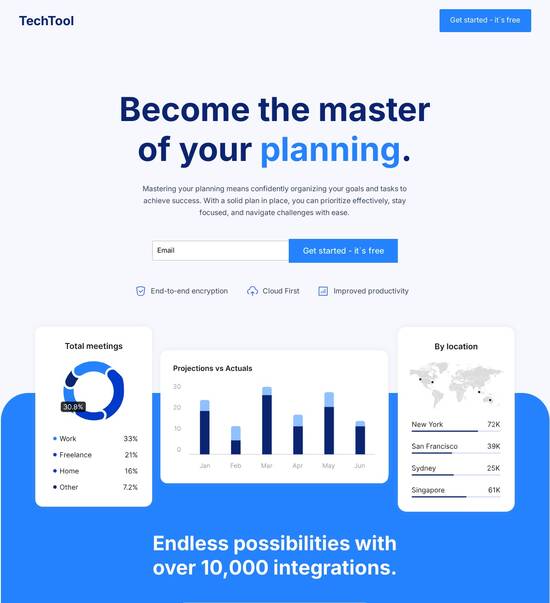
HTML page template for Scrum masters
Use TemplateAbout template
Attract clients and showcase your skills with style using our landing page templates for Scrum masters. Let's convert those visitors into clients!
Recommended templates

Easy to build without coding
With the intuitive drag-and-drop builder, anyone on your team can create high-converting pages without any knowledge of code or design. Make enhancements to your landing page with custom widgets using Javascript, HTML/CSS, or third-party scripts.

Multiple layouts for any industry and goal
Select from 500+ landing page layouts built to boost conversions across industry-specific scenarios. Customize them by adjusting fonts, adding images, and generating on-brand content with the AI assistant. Quickly scale with Instablocks® and Global Blocks that you can save, reuse, and update globally.

Loads fast and looks polished on any device
Every template is responsive, which means they present professionally on any device and load blazingly fast with our Thor Render Engine. You can also power them up with Google AMP technology to deliver an unparalleled mobile experience and drive higher conversions.

Robust analytics & experimentation
Get real-time updates and reporting across all your devices, showing the number of visitors, conversions, cost-per-visitor, and cost-per-lead. Launch AI-powered experiments, run A/B tests, and use heatmaps to analyze user behavior, then optimize your landing page to maximize conversions.







Easy to build without coding
With the intuitive drag-and-drop builder, anyone on your team can create high-converting pages without any knowledge of code or design. Make enhancements to your landing page with custom widgets using Javascript, HTML/CSS, or third-party scripts.
Multiple layouts for any industry and goal
Select from 500+ landing page layouts built to boost conversions across industry-specific scenarios. Customize them by adjusting fonts, adding images, and generating on-brand content with the AI assistant. Quickly scale with Instablocks® and Global Blocks that you can save, reuse, and update globally.
Loads fast and looks polished on any device
Every template is responsive, which means they present professionally on any device and load blazingly fast with our Thor Render Engine.
Robust analytics & experimentation
Get real-time updates and reporting across all your devices, showing the number of visitors, conversions, cost-per-visitor, and cost-per-lead. Launch AI-powered experiments, run A/B tests, and use heatmaps to analyze user behavior, then optimize your landing page to maximize conversions.
All the features you need to build scrum master templates
Explore more featuresLearn how to build scrum master template
FAQs
Leading the way in building high-performing landing pages





A comprehensive guide to using Instapage for landing page creation
Instapage is a powerful platform that helps marketers craft high-converting landing pages efficiently. With its intuitive interface and vast resources, users can quickly launch targeted pages designed to capture leads and enhance marketing performance. This guide will provide step-by-step instructions on maximizing the potential of Instapage for your campaigns across various industries.
Understanding the basics of Instapage
Instapage facilitates the creation of landing pages tailored to specific audiences without needing technical skills. With a library of over 100 conversion-optimized templates, marketers can easily select and modify pre-built lead generation elements. This flexibility allows for rapid deployment of pages that adapt to the needs of various sectors like business services, education, and financial services.
- User-friendly drag-and-drop editor: Quickly design visually appealing landing pages.
- Access to high-quality templates: Start with proven designs to ensure higher conversion rates.
- Lead generation tools built-in: Incorporate forms and CTAs seamlessly.
- A/B testing capabilities: Optimize campaigns based on real-time data-driven decisions.
Step 1: Crafting your landing page
When crafting your landing page, consider the following elements:
- Choose a template that aligns with your brand and campaign goals. Instapage offers diverse templates for various industries.
- Add content that resonates with your target audience; ensure messaging highlights key value propositions.
- Incorporate lead capture forms strategically; they should be easy to find and fill out.
Step 2: Optimize for conversions
Optimizing your landing page is critical to its success. Use the built-in optimization tools within Instapage:
- Leverage heatmaps to analyze user behavior on your page, identifying the most engaging elements.
- Run A/B tests to determine which content variations yield the best results.
- Review analytics dashboards regularly to adjust strategies based on performance metrics.
Step 3: Personalization and collaboration
To further enhance engagement, personalize your landing pages by using Instapage's dynamic text replacement feature, which tailors content to specific user segments. Enable collaboration among team members to expedite the page-building process, allowing for real-time feedback and edits.
By following these steps, you can maximize the effectiveness of your landing pages on Instapage. The platform is designed to empower marketers, making it easier to achieve conversion goals and meet the demands of dynamic marketing environments.
Start creating high-performing landing pages with Instapage today. Take advantage of our templates and tools to elevate your marketing strategy and turn visitors into leads effortlessly.
People also ask about HTML page template for Scrum masters
HTML page template for Scrum Masters
Understanding the essence of Agile Scrum for Scrum Masters
Agile Scrum is a foundational framework within the wider Agile methodologies aimed at enhancing team collaboration and productivity. While Agile encompasses various approaches, Scrum stands out due to its structured yet flexible nature. The Agile manifesto emphasizes individuals and interactions over processes and tools, which is at the heart of Scrum as well.
Key principles of Scrum include: transparency, inspection, and adaptation. Teams are encouraged to share their progress openly, regularly review their strategies, and adjust their workflows to better meet project goals. This continuous cycle allows teams to respond effectively to changes in project requirements or market dynamics, making Scrum particularly useful in today’s fast-paced environments.
The role of a Scrum Master
The Scrum Master plays a pivotal role in the Scrum framework, acting as a facilitator for the Scrum team. This individual is responsible for ensuring that the Scrum framework is understood and enacted within the team. Responsibilities include coaching team members on Agile principles, removing roadblocks that impede progress, and fostering an environment conducive to communication and collaboration.
Effective Scrum Masters possess key skills such as strong communication, empathy, and conflict resolution abilities. These traits enable them to bridge gaps between stakeholders and team members, ensuring everyone is aligned with project goals. By fostering a culture of collaboration, Scrum Masters impact not only team dynamics but also contribute to the overall success of projects.
The importance of using HTML page templates for Scrum boards
HTML page templates for Scrum boards significantly enhance team collaboration. These templates provide a visual representation of project progress and help team members understand their roles within the larger framework. By using a structured visual format, teams can improve communication and clarity around tasks, deadlines, and responsibilities.
Case studies from various organizations illustrate the positive impact of Scrum board templates. Companies that adopted structured templates experienced improved project visibility, leading to better decision-making and accountability among team members. For instance, a tech firm implemented an HTML Scrum board that highlighted progress and roadblocks in real time, enabling rapid adjustments and increased productivity.
Streamlining sprint planning processes
Using an HTML template helps streamline sprint planning processes, enabling teams to balance tasks according to their capacity. The template allows Scrum teams to visualize workload distribution effectively, thereby preventing overcommitment and burnout. By clearly delineating task ownership and deadlines, Scrum Masters can better manage expectations and outcomes.
A well-designed board template not only organizes tasks but also enhances the preparation for sprints. Team members can quickly assess what has been completed and what remains. This organized approach encourages collaboration and helps identify potential risks before they escalate, facilitating a smooth sprint execution.
Essential components of an HTML page template for Scrum Masters
Creating an effective Scrum board template involves several key structural components. The standard format typically includes three main categories: To Do, In Progress, and Done. Each category allows team members to track the status of their tasks at a glance and ensures that accountability is clear.
Additionally, integrating a burndown chart within the template provides a visual indication of progress over time. These charts are instrumental in helping teams stay on track with their sprint goals and assess whether they are meeting timelines effectively.
User story template
Capture specific requirements and expectations for each feature.
Sprint planning template
Organize tasks and set achievable goals for the sprint duration.
Project plan template
Provide an overarching view of project goals, timelines, and milestones.
Creating and customizing your HTML page template
Developing a customized HTML page template requires a structured approach. First, set up your development environment by selecting an appropriate code editor and establishing the necessary files for your template. An ideal starting point will include HTML for structure, CSS for styling, and JavaScript for interactivity.
Understanding coding essentials like HTML tags, CSS properties, and JavaScript functions will greatly assist in creating an effective Scrum board template. As you lay down the framework, consider how each component interacts to ensure seamless functionality and reliability across devices.
Customization is crucial for catering to unique team needs. Each project may have different workflows, and utilizing feedback from team members can enhance the template's usability. This feedback loop allows Scrum Masters to fine-tune their boards, ensuring they meet evolving project demands.
Maximizing efficiency in tracking tasks
To maximize task tracking efficiency, it is vital to utilize effective management features within the chosen HTML template. This can include categorizing tasks by priority or assigning them to specific team members. Enhanced tracking capabilities help make sure that nothing falls through the cracks during the sprint cycle.
For instance, implementing checklists for each task can help in maintaining focus on essential actions. As tasks progress, team members can indicate their completion, providing quick visibility on workload distribution.
Integrating Agile tools for real-time collaboration
HTML templates for Scrum boards can be further improved by ensuring compatibility with popular Agile project management tools. For example, integrating tools like Jira or Trello can support real-time updates, keeping everyone aligned regardless of their physical location. This level of collaboration is essential, especially for remote or hybrid teams.
By syncing templates with Agile tools, Scrum Masters can facilitate better communication, share updates instantly, and streamline reporting efforts. This integration not only simplifies the Scrum process but also enhances overall team efficiency.
Innovative practices within Scrum boards
Visual data representation is a valuable practice in agile environments. Utilizing a visual burndown chart template within an HTML page can significantly aid team members in tracking their progress. Visuals help simplify complex data, making it more digestible and usable for ongoing discussions about project states or sprint effectiveness.
Likewise, enhancing user stories with visuals such as diagrams or flowcharts can facilitate understanding among team members. These elements encourage in-depth discussions about requirements and work alignment, ultimately resulting in better product outcomes.
Feedback loops and continuous improvement
Setting up retrospective templates in HTML brings continuous improvement to the forefront of Scrum practices. These templates can guide teams in reviewing past sprints, assessing what went well, what didn’t, and what actionable steps can be taken moving forward.
Such retrospectives highlight the importance of iteration in agile methodologies, fostering an adaptive culture where teams are encouraged to learn and grow from experiences. This commitment to continuous improvement drives project success and enhances team dynamics over time.
Illustrative examples of successful implementation
Real-world examples of organizations that implemented HTML page templates for Scrum boards showcase the transformation of their workflow. For instance, a financial services company integrated a custom Scrum template that improved their project tracking and reporting by reducing time spent in meetings and increasing engagement among team members.
Key takeaways from these case studies often reveal that establishing a repository of Scrum templates can lead to notable efficiencies. By sharing and refining templates collectively, organizations foster a sense of ownership, encouraging teams to customize their boards according to specific project demands.
Future trends in Agile Scrum and HTML templates
Emerging technologies are poised to impact Agile methodologies significantly, particularly through the use of artificial intelligence and machine learning in task estimation and tracking. These advancements can aid Scrum teams in predicting timelines more accurately and identifying potential bottlenecks based on historical data.
Furthermore, collaborative platforms continue to evolve, bringing new dimensions to Scrum practices. As tools improve, Scrum Masters will need to adapt their templates and processes to leverage these advancements effectively, ensuring alignment with ever-changing project landscapes and team dynamics.
The transformation of team dynamics through templates
HTML page templates can play a vital role in building trust and empowerment within teams. By providing structured accountability through clearly defined tasks and ownership, team members feel more responsible for their contributions. This shared accountability fosters an environment where communication is encouraged, and project success is a collective goal.
Success stories from various teams often highlight measurable outcomes resulting from structured templates. Quantitative benefits include increased project delivery speed and reduced time spent on administrative tasks. Qualitative improvements reflect enhanced communication and synergy among team members, underscoring the value of investing time in developing effective Scrum board templates.
Ready to skyrocket conversions?
Supercharge your ad campaigns with high-performing landing pages
Get started














